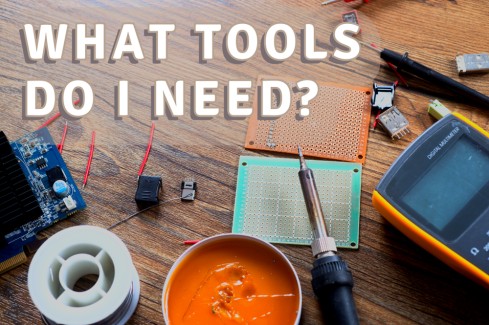Contrary to popular belief, expensive tools are not necessary when building custom robots. Tools such as oscilloscopes, CNC machines, laser cutting machines, etc. are usually reserved for the hobbyist who makes many new robots each year, schools, companies, or other institutions. These types of tools also make it fast and easy to produce "professional" grade prototypes. With some time and patience, you can achieve very accurate and professional results with a minimum investment. The basic tools you should consider when looking to build your first robot or robots are as follows

Unless you are planning to make an R/C toy or pre-programmed kit, you will need a visual interface to program your robot – this means a computer with a screen, keyboard, mouse, and connection ports (USB and Serial are most common). Feel free to use either a desktop or a laptop. Although an old-generation Pentium has the hardware capability to suit most needs, modern operating systems require slightly faster machines and new products/software tend not to support old operating systems. If your computer is running Windows 2000, XP, VISTA, Linux, or MAC OS/X, you probably do not need to upgrade. The main components to consider when assembling a computer intended for robotic programming are RAM, Hard drive (HDD) type/capacity, USB/Serial ports, motherboard, and processor. Most importantly, try to ensure all the chosen components work well with one another (bus speeds, etc.).

A Multimeter is actually a simple device used primarily to measure voltage and resistance and to determine if a circuit is closed. Similar to debugging computer code, the Multimeter helps you "debug" your electronic circuits.

A readily available supply of thin wood and/or Plexiglas to make the mechanical frame is very useful. Metals such as aluminum and steel are often restricted to those with access to a machine shop although thin aluminum can be cut with shears and bent by hand. Mechanical frames can even be built from household items such as plastic containers. Although other materials such as plastics (aside from Plexiglas), or more exotic materials like fiberglass and carbon fiber are possible, they will not be considered in this guide. Several manufacturers have noted that it is not easy for most hobbyists to produce their own mechanical parts and have created modular mechanical parts. A leader in this is Lynxmotion which offers a wide range of robotic designs as well as the parts needed to make your own custom robots.
Screwdrivers and pliers of various types and sizes (including jeweler's toolset: small screwdrivers commonly available at dollar stores) are necessary. A drill (preferably a drill press for straight holes) is also important. A hand saw for cutting building materials (or a router) is also an important asset. If budget allows, a small tabletop band saw ($200 range) is definitely a tool to consider.

A solderless breadboard allows you to optimize your layout and connect components with ease. Along with a solderless breadboard, you should purchase a pre-formed jumper wire kit which consists of pre-cut and bent wires intended to be used with a solderless breadboard. This makes connections very easy.
In the image above (a generic solderless breadboard), the vertical "outer" pins are all connected in columns, whereas the horizontal "inner" pins are connected in groups of five. The outer vertical pins are intended to be used for common voltage and ground. We encourage enthusiasts to tackle soldering after they have successfully completed several circuits. As your designs become more advanced and you build more and more robots, you will most likely consider buying a wider range of tools, complementary electronics, and devices to make creating robots easier and faster.



